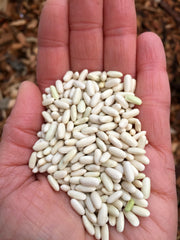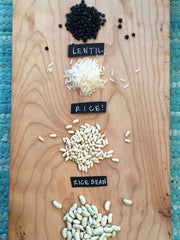Bean, Bush Dry, 'Hungarian Rice Bean'
(P. vulagaris) Why is no one planting these beans?! Now, we cannot make you, but you will be happy if you sow these and then eat them. Promise! Also, we will be happy, and spreading happiness is always a win...♥
In a brief mention of this charming variety, buried within a description of the Comtesse de Chambord rice bean, Vilmorin's The Vegetable Garden from 1885 states that there is a "very small-seeded variety of this plant, which produces vast numbers of pods". Vilmorin calls this the Haricot Nain de Hongrie, Hungarian Dwarf Rice Bean. While these two appear together in print, the Hungarian Rice Bean is likely more closely related to the Flageolet Vert, with whom it shares a slender, oblong seed shape and a proclivity to produce many pods. Due to the petite dimensions, rice beans cook up rather quickly, 25-30 mins, without the need to soak beforehand. The cooked beans are toothsome and creamy, their skin keeping them together while cooking but easily yielding to the bite. Excellent dressed lightly with salt and olive oil, the eye-catching miniature seeds also have us dreaming of other tiny foods to pair with. Truly a unique bean at 1/4" long and 1/8" wide, highly recommended! Amazing flavor in a tiny package.
95 days dry. UO
Packet: 1/2 oz (~250 Seeds)
Availability: In stock
Growing Info
SOWING:
Direct seed after the last frost date when the soil has warmed.
Note: Beans prefer well-drained, warm soil.
PLANTING DEPTH:
1"
SPACING:
3-5" between plants with 12-24" between rows*
*Pole beans require 5+' between rows.
EMERGENCE:
5-10 days @ soil temp 65-90F
LIGHT:
Full sun to part shade
FERTILITY:
Light to Moderate. Beans can produce their own usable nitrogen from atmospheric nitrogen through a symbiotic relationship with bacteria that colonize specialized nodules in their roots. Too much soil fertility can cause excessive vegetative growth at the expense of pod set and maturity.
Beans prefer well-drained warm soil with a pH between 6.0-7.0.
ADDITIONAL NOTES:
Beans prefer warm soils and may rot at lower temperatures. This is particularly true for white-seeded varieties. You love beans. Patience.
It can be quite beneficial to mix bean seeds with commercially available bacterial "inoculants" to encourage the beneficial symbiotic relationship in the growing plant's root nodules, especially if growing on ground that hasn't been planted with beans before. This can increase yields and improve plant health.
Avoid picking/weeding beans when the plants are wet. This will help prevent the spread of disease.
Provide a trellis for pole beans.
White-seeded varieties are more susceptible to rot when seeded in cool, wet, early-season conditions.
Sow Snap Beans every few weeks for continued harvests.
Harvest dry beans when the pods are brown and dry.




